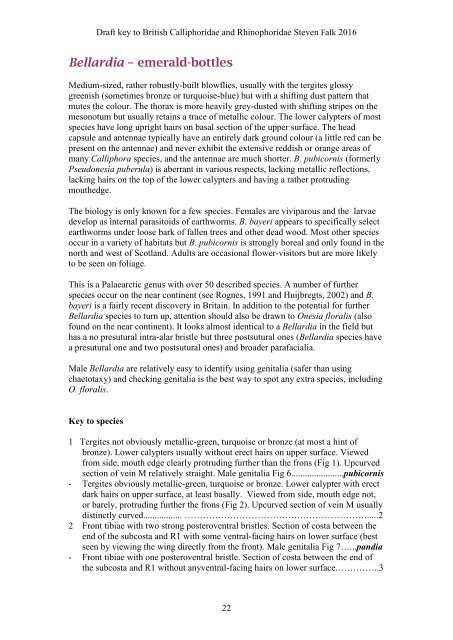BRITISH BLOWFLIES (CALLIPHORIDAE) AND WOODLOUSE FLIES (RHINOPHORIDAE)
4cmTmdCuA
4cmTmdCuA
Create successful ePaper yourself
Turn your PDF publications into a flip-book with our unique Google optimized e-Paper software.
Draft key to British Calliphoridae and Rhinophoridae Steven Falk 2016<br />
Bellardia – emerald-bottles<br />
Medium-sized, rather robustly-built blowflies, usually with the tergites glossy<br />
greenish (sometimes bronze or turquoise-blue) but with a shifting dust pattern that<br />
mutes the colour. The thorax is more heavily grey-dusted with shifting stripes on the<br />
mesonotum but usually retains a trace of metallic colour. The lower calypters of most<br />
species have long upright hairs on basal section of the upper surface. The head<br />
capsule and antennae typically have an entirely dark ground colour (a little red can be<br />
present on the antennae) and never exhibit the extensive reddish or orange areas of<br />
many Calliphora species, and the antennae are much shorter. B. pubicornis (formerly<br />
Pseudonesia puberula) is aberrant in various respects, lacking metallic reflections,<br />
lacking hairs on the top of the lower calypters and having a rather protruding<br />
mouthedge.<br />
The biology is only known for a few species. Females are viviparous and the larvae<br />
develop as internal parasitoids of earthworms. B. bayeri appears to specifically select<br />
earthworms under loose bark of fallen trees and other dead wood. Most other species<br />
occur in a variety of habitats but B. pubicornis is strongly boreal and only found in the<br />
north and west of Scotland. Adults are occasional flower-visitors but are more likely<br />
to be seen on foliage.<br />
This is a Palaearctic genus with over 50 described species. A number of further<br />
species occur on the near continent (see Rognes, 1991 and Huijbregts, 2002) and B.<br />
bayeri is a fairly recent discovery in Britain. In addition to the potential for further<br />
Bellardia species to turn up, attention should also be drawn to Onesia floralis (also<br />
found on the near continent). It looks almost identical to a Bellardia in the field but<br />
has a no presutural intra-alar bristle but three postsutural ones (Bellardia species have<br />
a presutural one and two postsutural ones) and broader parafacialia.<br />
Male Bellardia are relatively easy to identify using genitalia (safer than using<br />
chaetotaxy) and checking genitalia is the best way to spot any extra species, including<br />
O. floralis.<br />
Key to species<br />
1 Tergites not obviously metallic-green, turquoise or bronze (at most a hint of<br />
bronze). Lower calypters usually without erect hairs on upper surface. Viewed<br />
from side, mouth edge clearly protruding further than the frons (Fig 1). Upcurved<br />
section of vein M relatively straight. Male genitalia Fig 6.......................pubicornis<br />
- Tergites obviously metallic-green, turquoise or bronze. Lower calypter with erect<br />
dark hairs on upper surface, at least basally. Viewed from side, mouth edge not,<br />
or barely, protruding further the frons (Fig 2). Upcurved section of vein M usually<br />
distinctly curved................. …………………………………………………….....2<br />
2 Front tibiae with two strong posteroventral bristles. Section of costa between the<br />
end of the subcosta and R1 with some ventral-facing hairs on lower surface (best<br />
seen by viewing the wing directly from the front). Male genitalia Fig 7…...pandia<br />
- Front tibiae with one posteroventral bristle. Section of costa between the end of<br />
the subcosta and R1 without anyventral-facing hairs on lower surface.…………..3<br />
22


